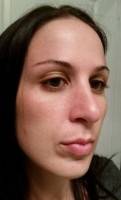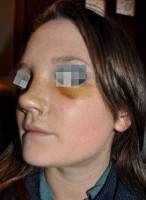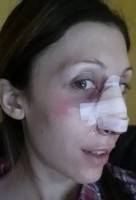What to look for in your free rhinoplasty consultation
That is a bit suspicious to have the doctor no examine inside your nose during your consultation.
A lot can be gleaned via seeing the outside of your nose during an initial assessment (done online with someone from out of state or another country for example), but it is important to have a thorough nasal exam before making a final rhinoplasty surgical plan.
Check out my web reference link below to read more about the free rhinoplasty consultation. (Thomas A. Lamperti, MD, Seattle Facial Plastic Surgeon)
Is it possible to create a plan for rhinoplasty without touching and examining inside the nose? Absolutely.
Many of us have consultations with prospective patients all over the word and come up with a plan prior to having that person assume the cost of travel arrangements.
That being said, proper examination must be completed during a history and physical or at some point before proceeding to surgery. Septal perforations or sinonasal pathology will not be visible from the outside but will dramatically change the rhinoplasty procedure.
The bigger question to me is whether it is wise to proceed with a surgeon you do not have 100% confidence in. Trusting your surgeon is more important in rhinoplasty then with any other facial plastic procedure.
The nose takes a long time to evolve into its final shape and form after surgery. Having insecurities about your surgeon before the procedure can lead to dissatisfaction after.
Meet as many people as you need to make sure have 100% confidence that you have selected the correct surgeon for you. (Christopher Kolstad, MD, San Diego Facial Plastic Surgeon)
The results you see in before and after pix, thoroughness of surgeon during consultation, your intuition, comfort, and confidence level, and certification by the American Board of Plastic Surgery are, in my opinion, all important criteria for surgeon selection. Consider seeing both surgeon #3 and surgeon #4. (Steve Laverson, MD, San Diego Plastic Surgeon)
Does the surgeon need to touch and look up the nose before surgery?
Yes, absolutely. It is necessary to palpate (touch) the nose before surgery to assess the strength of the cartilage support so that a good plan can be made. It is also necessary to look inside the nose to see if any issues need to be addressed there.
I would bet that this surgeon did not do too many rhinoplasties in his training and that this is not one of his specialties. I would look for a surgeon that specializes in rhinoplasty as it is a complicated procedure. (Jonathan Pontell, MD, FACS, Philadelphia Facial Plastic Surgeon)
Which surgeon to choose
It is really important for you to be comfortable with your surgeon and trust they do good work. I would certainly have wanted to see more than 3 cases a doctor did, but you have to do what you think is best. Doesn’t sound like you are crazy about either one. (Ronald J. Edelson, MD, San Diego Plastic Surgeon)
You have to decide who your trust and who does good work. Sometimes patients do not like photos posted on line and so that can be difficult, but certainly more photos should be available to view in the office. (Steven Wallach, MD, Manhattan Plastic Surgeon)
Your free rhinoplasty consultation should contain a physical examination of your nose.
It is common practice for your surgeon to examine your nose before considering performing Rhinoplasty Surgery. We check the thickness and elasticity of your skin, the amount of bone and cartilage in your nose, along with an internal nasal examination to visualize your airway. (Eric M. Joseph, MD, West Orange Facial Plastic Surgeon)
Surgeon should look inside the nose during free rhinoplasty consultation
I believe that a surgeon that is going to operate the nose should examine it o the best of his ability. This means looking inside the nose to examine the septum, turbinates, and the nasal valve. It, goes with out saying that he should also ask you certain questions during the consultation to see if you have any issues with breathing or allergic conditions. The examination should also focus on the external nose. The nose should be felt for bumps, humps, curvatures, and strength of the underlying cartilages.
If the surgeon does not do these basic tasks, he should not be considered for the surgery. It’s that plain and simple. (Andres Bustillo, MD, FACS, Miami Facial Plastic Surgeon)


